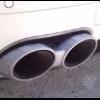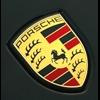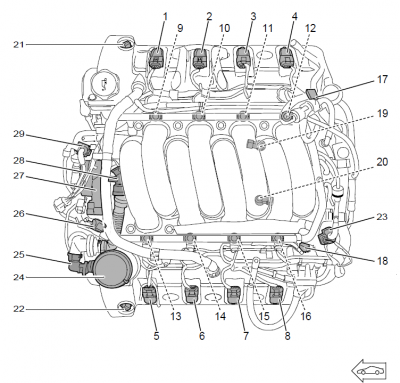Top View
1- Ignition bar module, cylinder 1, bank 1
2 - Ignition bar module, cylinder 2, bank 1
3 - Ignition bar module, cylinder 3, bank 1
4 - Ignition bar module, cylinder 4, bank 1
5 - Ignition bar module, cylinder 5, bank 2
6 - Ignition bar module, cylinder 6, bank 2
7 - Ignition bar module, cylinder 7, bank 2
8 - Ignition bar module, cylinder 8, bank 2
9 - Fuel injector, cylinder 1, bank 1 (hidden)
10 - Fuel injector, cylinder 2, bank 1 (hidden)
11 - Fuel injector, cylinder 3, bank 1 (hidden)
12 - Fuel injector, cylinder 4, bank 1 (hidden)
13 - Fuel injector, cylinder 5, bank 2 (hidden)
14 - Fuel injector, cylinder 6, bank 2 (hidden)
15 - Fuel injector, cylinder 7, bank 2 (hidden)
16 - Fuel injector, cylinder 8, bank 2 (hidden)
17 - Inlet camshaft hall sensor, bank 1
18 - Inlet camshaft hall sensor, bank 2
19 - Knock sensor, bank 1 (hidden)
20 - Knock sensor, bank 2 (hidden)
21 - VarioCam solenoid valve, bank 1
22 - VarioCam solenoid valve, bank 2
23 - Ambient air solenoid valve
24 - Positive crankcase ventilation
25 - Three-way pressure valve
26 - Tank vent valve
27 - Throttle adjusting unit
28 - Positive crankcase ventilation heater
29 - Boost pressure control solenoid valve
Front View
1 - Mass air flow sensor, right (hidden)
2 - Mass air flow sensor, left
3 - Charge air cooler, right
4 - Charge air cooler, left
5 - Boost-pressure sensor
6 - Boost pressure control solenoid valve (hidden)
7 - Boost pressure control valve (waste gate) - mechanical, right
8 - Boost pressure control valve (waste gate) - mechanical, left (hidden)
9 - Vacuum accumulator (in intake distributor)
10 - Overrun recirculating air solenoid valve (hidden)
11 - Overrun recirculating air valve - mechanical, left
12 - Overrun recirculating air valve - mechanical, right
Rear View
1 - Secondary air valve - mechanical, left
2 - Ambient air solenoid valve
3 - Vacuum accumulator - integrated into intake distributor
4 - Coolant temperature sensor
5 - Secondary air valve - mechanical, right
Underside View
1- Oil level and temperature sensor
Oxygen Sensing
1- DME control module
2 - Secondary air injection pump, bank 1
3 - Secondary air valve - mechanical, bank 1
4 - Oxygen sensor in front of catalytic converter, bank 1
5 - Pre-catalytic converter, bank 1
6 - Oxygen sensor after catalytic converter, bank 1
7 - Main catalytic converter, bank 1
8 - Secondary air injection pump, bank 2
9 - Secondary air valve - mechanical, bank 2
10 - E-box in radiator tank with fuse and relay carrier
11 - Main catalytic converter, bank 2
12 - Oxygen sensor after catalytic converter, bank 2
13 - Pre-catalytic converter, bank 2
14 - Oxygen sensor ahead of catalytic converter, bank 2
Charge Measurement and Fuel Supply
1 - Mass air flow sensor, right
2 - Fuel injector, cylinder 1, bank 1
3 - Fuel injector, cylinder 2, bank 1
4 - Fuel injector, cylinder 3, bank 1
5 - Fuel injector, cylinder 4, bank 1
6 - DME control module
7 - Electric fuel pump, right
8 - EVAP canister
9 - Fuel tank
10 - Electric fuel pump, left
11 - Driver's door lock with switch for fuel pump supply
12 - Current distributor with cutoff relay under driver's seat
13 - KESSY control module
14 - E-box in radiator tank with fuse and relay carrier
15 - Pedal sensor
16 - Fuel injector, cylinder 8, bank 2
17 - Fuel injector, cylinder 7, bank 2
18 - Fuel injector, cylinder 6, bank 2
19 - Fuel injector, cylinder 5, bank 2
20 - Tank vent valve
21 - Mass air flow sensor, left
22 - Positive crankcase ventilation heater
23 - Throttle adjusting unit
Charge Measurement and Fuel Supply - additional items for Turbo
1 - Mass air flow sensor, right
2 - Overrun recirculating air valve - mechanical, right
3 - Turbocharger with boost pressure control valve (waste gate), right
4 - Boost-pressure sensor
5 - Boost pressure control solenoid valve
6 - Vacuum pump for brake booster
7 - Intake distributor with integrated vacuum reservoir (used to control overrun recirculating air valves, for example)
8 - DME control module
9 - Brake booster
10 - E-box in radiator tank with fuse and relay carrier
11 - Pressure sensor for brake booster
12 - Ambient air solenoid valve
13 - Turbocharger with boost pressure control valve (waste gate), left
14 - Overrun recirculating air valve - mechanical, left
Camshaft and Ignition Sensors
1 - Inlet camshaft vane-type adjuster, bank 1
2 - VarioCam solenoid valve, bank 1
3 - Ignition bar module, cylinder 1, bank 1
4 - Ignition bar module, cylinder 2, bank 1
5 - Ignition bar module, cylinder 3, bank 1
6 - Ignition bar module, cylinder 4, bank 1
7 - DME control module
8 - Hall sensor, bank 1
9 - Hall sensor, bank 2
10 - Ignition bar module, cylinder 8, bank 2
11 - Ignition bar module, cylinder 7, bank 2
12 - Ignition bar module, cylinder 6, bank 2
13 - Ignition bar module, cylinder 5, bank 2
14 - VarioCam solenoid valve, bank 2
15 - Inlet camshaft vane-type adjuster, bank 2
16 - Knock sensor, bank 2
17 - Knock sensor, bank 1
Temperature Control with Sensors
1 - Radiator fan, large (right)
2 - Ambient air temperature sensor
3 - Thermostat with housing
4 - Coolant temperature sensor
5 - DME control module
6 - Instrument cluster
7 - E-box in radiator tank with fuse and relay carrier
8 - Additional coolant circulation pump (also controlled by the DME in turbo engines only)
9 - Radiator fan, small (left)

-0001-0001.thumb.png.17f5bb25bf8ec261a17c21e6321c8492.png)


